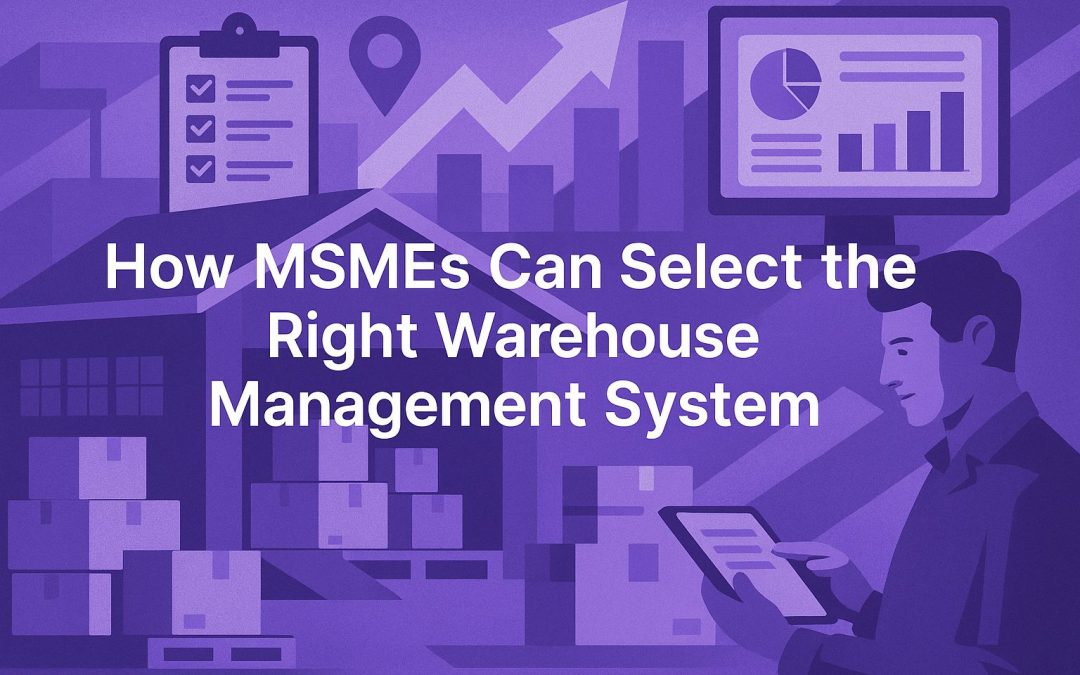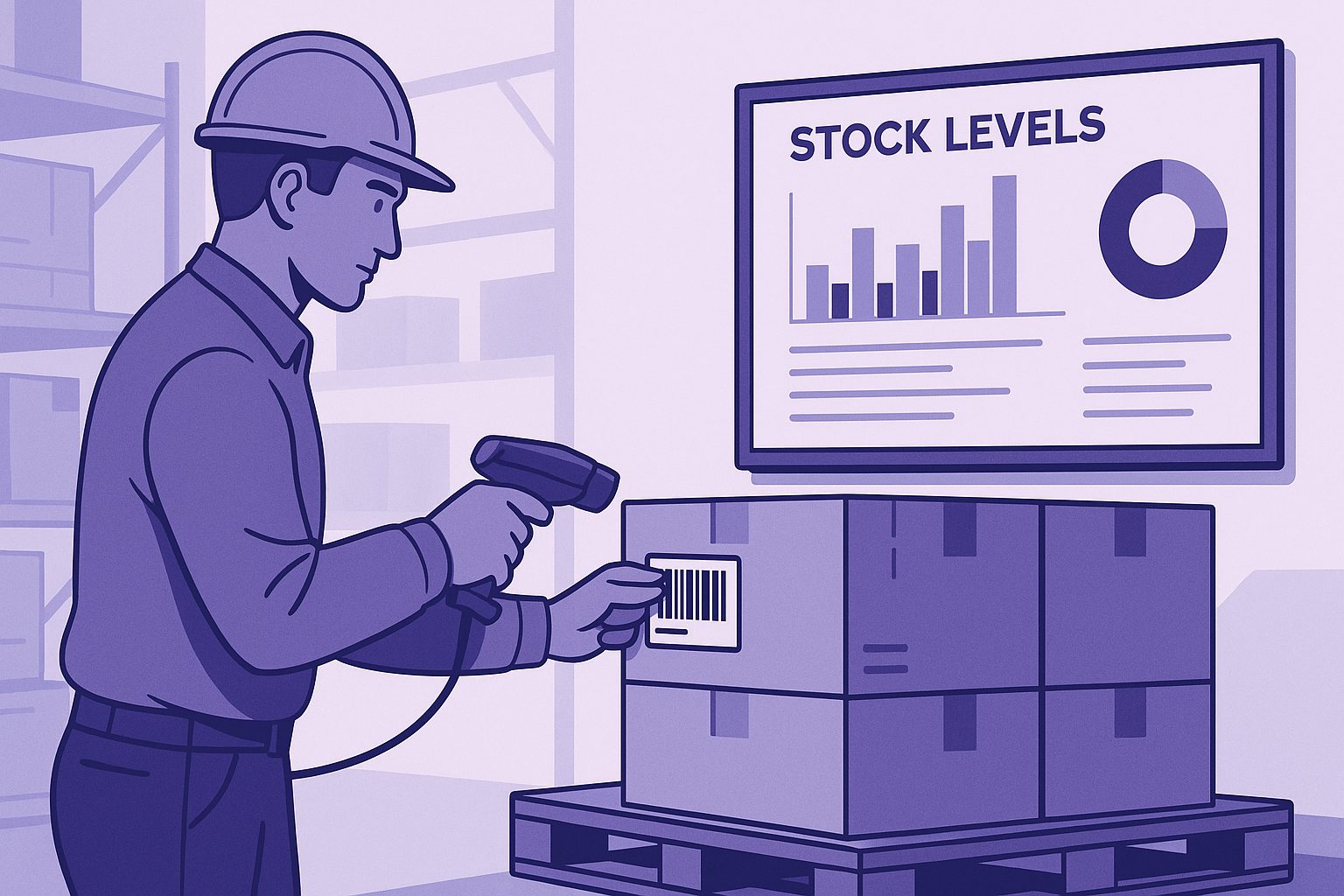Table of Contents
Most MSMEs treat the warehouse as a back-room function until a shipment goes wrong. Suddenly, every delayed dispatch, stockout, or wrong carton points to one silent culprit: poor control. That control is exactly what a warehouse management system delivers.
At its core, a warehouse management system is purpose-built warehouse software that turns chaotic racks and handwritten stock cards into structured, real-time inventory management. It records every inward gate entry, tracks each picking and packing step, and flags stock visibility gaps before they snowball into missed orders. Spreadsheets can list products, but they cannot follow a fast-moving item through multiple aisles, across hubs, then onto the delivery vehicle—this system can.
For MSMEs shipping across states, even a modest jump in daily orders stretches manual checks thin. A dependable warehouse management system plugs that gap by automating barcode scans, dispatch tracking, and stock audits. The result is sharper inventory accuracy, fewer returns, and quicker order fulfillment.
Consider a Bhopal-based home-decor exporter juggling 1,200 SKUs. Every festival season, stock mismatches ate into margins and goodwill alike. After adopting cloud-based warehouse automation, the firm trimmed picking errors by 35 percent and freed two staff members for customer support. Those gains illustrate why a right-sized warehouse management system is no luxury—it is an operational safety net that lets a growing business focus on sales instead of daily fire-fighting.
Signs Your MSME Needs a WMS
A warehouse rarely implodes in a single day. Trouble gathers the way monsoon clouds do—slowly, layer on layer—until one afternoon every aisle feels cluttered and the dispatch board glows red. When that moment arrives, updating to a reliable warehouse management system stops being a future project and becomes tomorrow morning’s agenda.
Red Flags You Can’t Ignore
These issues crop up first. Treat them as the siren before the storm:
- Stock counts swing wildly between morning and evening tallies.
- Pick–pack cycles overrun courier deadlines, forcing costly same-day rush bookings.
- Return parcels carry notes like “wrong item” or “extra piece,” hinting at barcode slips.
- Three spreadsheets claim to hold “live” inventory, yet none agree on actual numbers.
- Back-order sheets thicken during peak sales because system updates lag the shop floor.
The Rupee Drain Few Teams Measure
Every mismatch, every late truck, every manual recount chips away at working capital. Extra freight charges pile up quietly, and overtime becomes a line item nobody questions. A focused warehouse management system curbs those leaks by linking each scan, move, and dispatch to one real-time dashboard.
Field Story: Pune Gasket Supplier
One mid-sized gasket maker near Pimpri added two overtime shifts each week just to reconcile dispatch slips. After introducing a mobile WMS, overtime vanished, and order accuracy jumped close to one-third within one quarter.
Field Story: Chennai Electronics Wholesaler
Festive product launches once left Chennai’s biggest outlets empty while slow branches sat on excess. A cloud-based WMS delivered a single view of forty stores, letting the team shift stock overnight and shave ₹1.2 lakh off monthly freight.
Decide Before Routine Costs Spike
Two recurring red flags in the same quarter signal action time. Upgrading to a scaled-down warehouse management system is less a tech purchase than an insurance policy—one that shields customer promises and stops cash from dribbling out with every mislabeled carton.
Choosing the Right WMS: A Step-by-Step Guide for MSMEs
A rushed purchase can trap an MSME in costly upgrades and frustrated staff. Follow this clear roadmap to secure a warehouse management system that fits both present needs and future growth.
Set an Honest Budget
Most SaaS plans charge by user or by number of transactions. For small teams, a cloud warehouse management system typically costs ₹2,000–₹4,000 per user each month, far lower than perpetual-license software that demands a steep upfront fee plus annual maintenance. Include hardware—barcode scanners, label printers, rugged tablets—in the same spreadsheet to see true ROI.
Nail the Feature Shortlist
List no more than eight “must-haves.” For most MSMEs, the essentials include:
- Mobile app for live stock visibility
- Barcode system and quick label printing
- Seamless inventory management integration with Tally or ERPNext
- Simple warehouse dashboard to track picking speed and dispatch tracking
- Role-based access for staff with varied IT comfort levels
Cut any feature that looks impressive yet won’t solve a daily pain. Fancy warehouse automation modules waste rupees if order volumes stay below 500 a day.
Vet the Vendor, Not Just the Demo
Ask for two live customer references of similar size and sector. Check how often support tickets close within promised turnaround time. Scrutinise data-hosting clauses; a warehouse management system that stores data on offshore servers may breach local compliance needs. Finally, insist on a total cost sheet that includes upgrades, user additions, and SMS alerts.
Run a Tight Pilot
Limit the pilot to one zone, one courier lane, and at least 100 SKUs. Benchmark cycle counts, order fulfilment time, and stock visibility before and after the trial. A Coimbatore garment exporter did exactly this and saw picking errors fall from 8 percent to 3 percent in four weeks. Repeat success, then roll the warehouse management system across all aisles.
Decision Key
If the pilot proves a 15 percent drop in dispatch errors and fits the budget cap, lock the licence immediately. Waiting only invites fresh overtime bills and growing customer churn. A right-sized warehouse management system earns its keep the moment overtime sheets start shrinking.
Sector-Specific Considerations for MSMEs
No two warehouses look alike. A factory floor in Peenya handles pressed steel, a textile trader in Surat juggles colour lots, and an online gadget store in Bengaluru races to beat same-day dispatch clocks. The best warehouse management system bends to these realities instead of forcing everyone into the same workflow. Use the checkpoints below to match software to shop-floor life.
Manufacturing Plants: Keep the Line Moving
Production stops cost far more than software fees, so the system must flag shortages early and trace every batch end to end.
- Batch traceability. Pair each incoming coil or chemical drum with the work order it feeds, then link the finished batch to its inspection record.
- Live line-side alerts. Tablet widgets warn supervisors when a part family drops below the two-shift buffer.
- Quarantine lanes. Put a “hold” status on suspect material so it cannot sneak into assembly until quality clears it.
Shop-floor snapshot. A forging unit outside Ludhiana set low-stock alerts at three hours before mill stoppage and trimmed unplanned downtime by one-fifth.
Trading & Distribution: High SKU, Higher Tempo
Distributors thrive on speed. Pallets arrive at dawn, cartons leave by noon, and every misplaced label inflates freight.
- Cross-dock ready. The warehouse management system should log goods at receiving, print a fresh label, and send the carton straight to dispatch.
- Branch-wise balancing. One dashboard tracks multi-location inventory in real time so surplus socks do not sit in Indore while Jaipur sells out.
- Plug-and-play 3PL links. Direct connectors to national warehouse networks let you rent extra racking for festival peaks without signing long leases.
Market snapshot. A Surat wholesaler handling 7,000 garment SKUs used on-demand 3PL space last Diwali. Turnaround jumped 30 percent and temporary storage bills fell because the extra bays vanished once the rush ended.
E-Commerce Sellers: Speed Rules Everything
Online buyers tap the cancel button the moment a promise slips, so accuracy and rapid returns matter as much as dispatch speed.
- Marketplace APIs. Pull orders straight from Amazon, Flipkart, and Shopify, eliminating copy-paste errors.
- Single-piece picking. Heat-map views highlight ageing carts so pickers clear them before starting bulk runs.
- Closed-loop returns. RMA screens sort “resale ready” phones from damaged units, update stock in seconds, and keep fake returns off the shelf.
Fulfilment snapshot. A Bengaluru gadget store moved from spreadsheets to a barcode WMS and clipped its return-to-stock cycle from 48 hours to 14, keeping hot SKUs live during flash-sale spikes.
The 3PL Safety Valve: Capacity on Tap
Demand in India swings with cricket seasons, harvests, and flash deals. A smart warehouse management system should talk to digital platforms that list verified 3PL sites across the country.
- Rent pallet rows by the day, not the quarter.
- Book transport and generate LR numbers in one window.
- Keep a unified stock count even when part of the load sits 1,500 km away.
Decision tip. If a vendor cannot show a live demo of this hand-shake, keep shopping. The feature saves capex now and keeps you light on your feet when the next sales surge hits.
Tuning the warehouse management system to the rhythms of each sector—and wiring it to flexible 3PL options—turns stock visibility into a daily habit, not a quarterly scramble.
Common Challenges & How to Avoid Them
Rolling out a warehouse management system often feels like flipping a switch, yet trouble sneaks in where nobody looks—during data migration, staff retraining, and real-time syncing with couriers. Spot these pitfalls early, and the system pays for itself in months instead of years.
Dirty Master Data
Every wrong SKU code carries forward into picking, packing, and reconciliation. Cleansing the item master before go-live saves endless error hunts.
- Audit barcodes, UOMs, and reorder points line by line.
- Freeze incoming SKU creation for one week to finish the cleanup.
Quick win. A Nagpur spare-parts dealer purged 6,200 duplicate codes and cut inventory variance from 9 percent to 2 percent within the first cycle count.
Half-Trained Staff
New screens intimidate pickers used to pen-and-paper. Without guided practice, they revert to old habits, and cycle times crawl.
- Run shift-based micro-sessions on the scanner app—15 minutes, no longer.
- Assign “floor champions” who answer questions in real time.
Field note. A Kochi seafood exporter rotated two champions per aisle. Within ten days pick speed hit 48 lines per hour, matching targets ahead of schedule.
Poor Courier Integration
If dispatch data lags, drivers wait, labels misprint, and LR numbers arrive after the truck rolls out.
- Test each courier API under load with 100 dummy orders.
- Keep a fallback PDF label in case the API stalls.
Pro tip. Measure label print time; anything above eight seconds per order raises red flags.
Forgetting Device Management
Dropped scanners and drained batteries stop work faster than any software bug.
- Stock two spare batteries for every handheld device.
- Mount chargers on end-of-aisle racks to encourage top-ups between picks.
On the floor. A Jaipur apparel brand lost 40 minutes daily searching for chargers. Wall-mounted docks fixed the issue overnight.
Decision checkpoint
If two or more of these challenges surface during the first month, pause new feature rollouts. Stabilise data, retrain users, and retest integrations before scaling further. A well-tuned warehouse management system becomes invisible once set up correctly—errors shrink, aisles clear, and dispatch promises turn into routine victories.
Conclusion
The warehouse once sat at the edge of the balance sheet, a silent cost. Today, it decides whether an MSME keeps clients or apologises for late boxes. A right-sized warehouse management system shifts that equation. Stock mismatches fade, dispatch boards clear, and customer service stops firefighting and starts planning.
For MSMEs shipping across states, the gains multiply. Faster cycle counts cut working capital lock-in. Real-time dashboards spot shortages hours before they bite. Cloud connectors open spare capacity in another city with a few clicks. Each win feels small, yet together they tilt margins firmly into the black.
The next step is simple: match pain points to features, price the package honestly, then pilot with one aisle, one courier lane, and one week’s worth of orders. If error rates drop and overtime shrinks, expand fast. Delay, and the same hidden leaks keep draining rupees every single shift.
Choose well, implement cleanly, and the warehouse stops acting like a cost centre. It becomes a growth engine—quiet, reliable, and ready for every new order that knocks on the loading dock.
Need reliable logistics solutions for your business?
Tata nexarc helps businesses streamline their supply chain with trusted transporters, competitive pricing, and real-time tracking—ensuring timely and cost-effective delivery across India.
FAQs
How does a WMS help comply with India’s GST e-way bill rules?
Can a warehouse management system run offline during network outages?
What cybersecurity measures should an MSME demand from a WMS vendor?
How is ROI calculated for a WMS investment?
Does a WMS support cold-chain operations?
Are government incentives available for adopting warehouse technology?
How does voice picking integrate with a WMS?
Can a WMS optimise energy usage in the warehouse?
What is slotting and does every WMS include it?
How does a WMS handle hazardous material storage rules?
Ananya Mittal blends a background in data science with a passion for writing, contributing to Tata Nexarc’s efforts in creating insightful, data-informed content for MSMEs. Her work focuses on exploring sector-specific challenges and opportunities across procurement, logistics, and business strategy. She is also involved in leveraging analytics to strengthen content performance and deliver actionable insights to India's growing B2B ecosystem.















